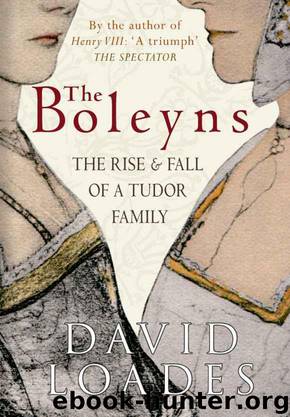The Boleyns: The Rise & Fall of a Tudor Family by David Loades

Author:David Loades [Loades, David]
Language: eng
Format: epub, mobi
Tags: History
Publisher: Amberley Publishing
Published: 2012-01-15T07:00:00+00:00
It could hardly have been a more composed or orthodox departure, and even Chapuys was impressed. The formalities were quickly completed, and her body was committed for burial beside that of her brother in the chapel of St Peter ad Vincula.
So the King had his desire, and was free to marry again, which he proceeded to do with what many considered to be indecent haste, taking Jane Seymour as his wife on 30 May, just eleven days after Anne’s death. Pope Paul III was encouraged, now that Anne and Catherine were both dead, to believe that England’s relations with the Holy See might be renegotiated. The Emperor was also optimistic of the same outcome, and before the news of Jane Seymour’s advent reached him was talking of a possible Portuguese bride for Henry.[366] However, the man who gained most from the demise of the Boleyn party was undoubtedly their chief rival, Thomas Cromwell, who now had no obvious challenger for the King’s confidence. The Dukes of Norfolk and Suffolk, in spite of the prestige of their rank, were no competition in terms of political astuteness, or in their ability to read the King’s moods. Nor was Jane Seymour, who was totally lacking Anne’s political intelligence, and seems to have had no agenda beyond that of general pacification. She was a meek and submissive soul; just what Henry needed after his bruising confrontation with Catherine and the constant edginess of his relationship with Anne.[367] Her brother Edward became Earl of Hertford in the wake of her elevation, but the Seymours did not constitute a party in the same sense as the Boleyns, and did not have the same type of agenda. In spite of his acquiescence in all that had happened, the Earl of Wiltshire now found himself excluded from the inner circle of the council, and lost the office of Privy Seal to Cromwell on 29 June. He did not give up, but rather seems to have set out to recover his position. He served the King loyally during the Pilgrimage of Grace in the autumn of 1536, paid his subsidy assessment in full, and was assiduous in attending the ceremonies of the Garter. In January 1538 he was back at court, and according to one report ‘well entertained’. When his wife Elizabeth died later in the same year there was even talk of his marrying Margaret Douglas, the King’s kinswoman by virtue of being the daughter of his sister Margaret by her second marriage.[368] However, his health was probably failing by then, and he died at Hever on 29 March 1539, having recovered neither power nor influence.
But was Anne guilty of any or all of the offences which were alleged to destroy her and the power of her family? Professor Ives thinks not, arguing that the evidence against her was flimsy and circumstantial, and would not stand up for a moment in a modern court of law.[369] Professor Bernard thinks differently, without denying the validity of the modern comparison.
Download
The Boleyns: The Rise & Fall of a Tudor Family by David Loades.mobi
This site does not store any files on its server. We only index and link to content provided by other sites. Please contact the content providers to delete copyright contents if any and email us, we'll remove relevant links or contents immediately.
| France | Germany |
| Great Britain | Greece |
| Italy | Rome |
| Russia | Spain & Portugal |
Fanny Burney by Claire Harman(25818)
Empire of the Sikhs by Patwant Singh(22213)
Out of India by Michael Foss(16337)
Leonardo da Vinci by Walter Isaacson(11960)
Small Great Things by Jodi Picoult(6131)
The Six Wives Of Henry VIII (WOMEN IN HISTORY) by Fraser Antonia(4821)
The Wind in My Hair by Masih Alinejad(4450)
The Lonely City by Olivia Laing(4148)
The Crown by Robert Lacey(4135)
A Higher Loyalty: Truth, Lies, and Leadership by James Comey(4066)
The Iron Duke by The Iron Duke(3671)
Millionaire: The Philanderer, Gambler, and Duelist Who Invented Modern Finance by Janet Gleeson(3604)
Sticky Fingers by Joe Hagan(3472)
Alive: The Story of the Andes Survivors by Piers Paul Read(3341)
Papillon (English) by Henri Charrière(3299)
Joan of Arc by Mary Gordon(3288)
Stalin by Stephen Kotkin(3113)
Aleister Crowley: The Biography by Tobias Churton(3046)
Ants Among Elephants by Sujatha Gidla(2943)
